The Singapore Tourism Industry is witnessing steady growth, driven by increasing domestic and international travel demand and government initiatives to promote the city-state as a premium tourism destination. Rising disposable incomes, improved connectivity, and the expansion of tourism infrastructure are facilitating broader participation in leisure, cultural, and business travel. The industry is being supported by the adoption of technology-enabled booking and service platforms, which streamline traveler experiences and enhance operational efficiency.
Efforts to promote sustainable and experiential tourism are attracting a wider range of visitors seeking personalized experiences. Tourism stakeholders are increasingly leveraging data analytics, digital marketing, and smart mobility solutions to understand traveler preferences and optimize services. As domestic travel continues to recover post-pandemic and consumer confidence strengthens, demand for diverse travel offerings is expanding.
Policy support, ongoing investments in attractions, and the development of integrated tourism ecosystems are expected to drive continued market growth The focus on seamless travel experiences, safety, and convenience positions the Singapore Tourism Industry for sustained expansion in the coming years.
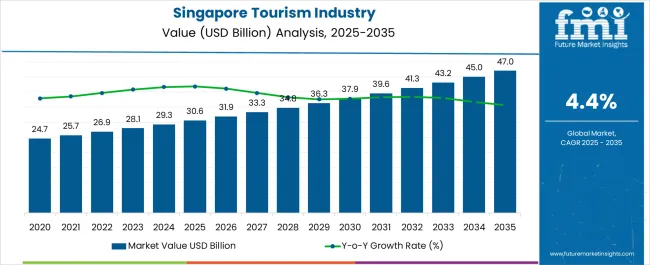
| Metric | Value |
|---|---|
| Singapore Tourism Industry Estimated Value in (2025 E) | USD 30.6 billion |
| Singapore Tourism Industry Forecast Value in (2035 F) | USD 47.0 billion |
| Forecast CAGR (2025 to 2035) | 4.4% |
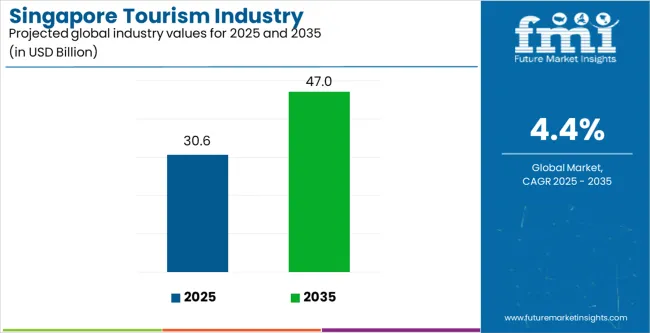
The market is segmented by Tourism Type, Booking Channel, and Tour Type and region. By Tourism Type, the market is divided into Domestic and International. In terms of Booking Channel, the market is classified into Online Booking, Phone Booking, and In Person Booking. Based on Tour Type, the market is segmented into Individual Travel, Professional Groups, and Group Travels. Regionally, the market is classified into North America, Latin America, Western Europe, Eastern Europe, Balkan & Baltic Countries, Russia & Belarus, Central Asia, East Asia, South Asia & Pacific, and the Middle East & Africa.
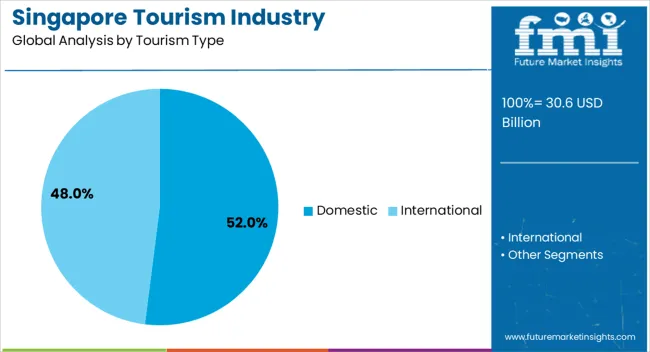
The domestic tourism segment is projected to hold 52.0% of the market revenue in 2025, establishing it as the leading tourism type. Growth is being driven by rising consumer interest in local travel experiences and government initiatives promoting staycations and regional tourism. Domestic travelers increasingly seek personalized and flexible travel options, which has encouraged service providers to offer tailored packages and activities.
Accessibility, cost-effectiveness, and convenience are key factors influencing domestic travel preferences. Seasonal promotions, local cultural experiences, and enhanced digital engagement further support adoption. The segment benefits from high repeat visitation rates and strong consumer confidence in domestic destinations.
Travel operators are increasingly leveraging technology to simplify bookings, provide customized itineraries, and offer contactless services, enhancing overall traveler satisfaction As domestic tourism continues to expand, it is expected to remain the largest contributor to revenue, supported by ongoing policy measures, infrastructure enhancements, and growing interest in local exploration.
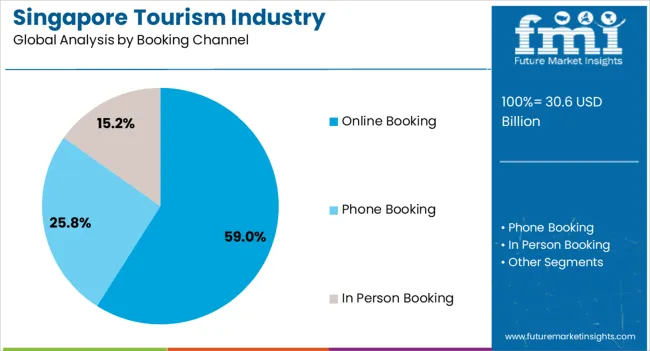
The online booking channel segment is anticipated to account for 59.0% of the market revenue in 2025, making it the leading booking channel. Growth is being driven by the convenience, accessibility, and real-time information offered by digital platforms, allowing travelers to plan and book trips efficiently. Online booking platforms enable comparison of prices, flexible scheduling, and instant confirmations, which improve user experience and satisfaction.
Integration with mobile apps, payment solutions, and personalized recommendations enhances adoption and customer engagement. Travel operators and tourism providers increasingly leverage digital channels to offer promotions, loyalty programs, and targeted packages.
The efficiency and scalability of online booking solutions reduce operational costs while expanding market reach As consumer preference shifts toward technology-driven travel solutions, the online booking channel is expected to maintain its leadership, supported by continued investment in digital infrastructure, smart platforms, and seamless end-to-end travel experiences.
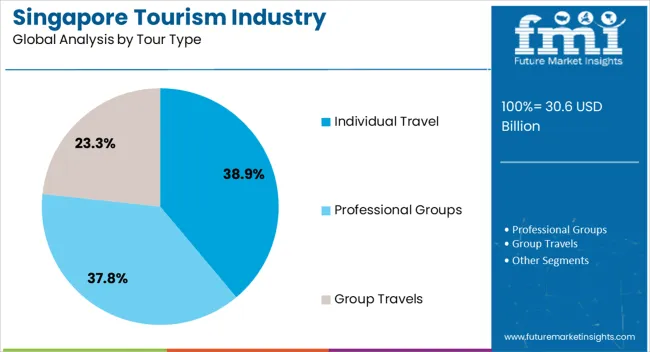
The individual travel segment is projected to hold 38.9% of the market revenue in 2025, establishing it as the leading tour type. Growth is driven by the rising demand for flexible, personalized, and self-paced travel experiences that allow travelers to customize itineraries based on their interests. Individual travelers increasingly seek unique and immersive experiences, including cultural, leisure, and wellness activities.
Digital tools and mobile applications enable easy planning, booking, and navigation, further supporting the popularity of this tour type. The segment benefits from changing consumer lifestyles, greater disposable income, and a preference for independent exploration over group packages.
Travel operators and service providers are adapting offerings to meet these preferences by providing curated experiences, on-demand services, and seamless support for solo travelers As interest in flexible and personalized travel continues to rise, individual travel is expected to maintain its leadership position, supported by technology integration, innovative experiences, and evolving consumer behavior.
The period from 2020 to 2025 was characterized by somewhat moderate growth of Singapore’s tourism industry. The market value amounted to USD 28,188.60 million, and the CAGR was 3.8%.
This moderate pace can be attributed to a decrease in global tourism industry, other destinations becoming more popular, and the organization’s inability to attract tourists for the second time successfully.
| Category | Historical Period from 2020 to 2025 |
|---|---|
| Market Valuation at the End of the Period | USD 28,188.60 million |
| CAGR | 3.80% |
| Key Trends | Sustainable tourism focus |
| Growth factors | Digital tech adoption |
The future predictions for 2035 seem more positive, as the CAGR is pegged to be at 4.4%. This period is likely to secure significant demand with developing niche markets. Also, advances in digital tools for optimizing the experience of tourists, increased attention to Eco practices could lead the market valuation to USD 45,050 million by 2035.
| Category | Forecast Period from 2025 to 2035 |
|---|---|
| Market Valuation at the End of the Period | USD 45,050 million |
| CAGR | 4.40% |
| Key Trends | AI-driven personalized experiences |
| Growth factors | Wellness tourism demand |
Role of the Singapore Tourism Board (STB)
Singapore Tourism Board (STB) works actively to promote the country via targeted campaigns and develop new tourism products and experiences. They specialize in unique industries such as deluxe tourism, medical tourism, and sustainable tourism to meet the needs of visitors of different types.
Travel agencies and tour operators are developing personal itineraries, adopting online booking and virtual tours through technology, and focusing on niche sectors such as culture and ecotourism.
The Singapore tourism industry is taking on this digital wave with open arms!
Online tourism booking sites, mobile applications, and contactless payment systems are making travel arrangements, booking, and in-destination experiences more convenient and effective. Technology is also being used by retail and F&B outlets through digital menus and online ordering, which are aimed at the same.
Theme parks, museums, and cultural attractions are never stagnant. They are always introducing something new. The goal is to create immersive and interactive experiences that are a perfect match for the digital generation.
Medical Tourism Central
First class health care facilities and highly specialized medical procedures make Singapore a leading destination for medical tourism. There are sophisticated hospitals, top ranked medical professionals and the name is familiar around the world in regard to healthcare services, which means that Singapore has become irresistible to those people who come from different parts of the world seeking the best treatment and operations.
MICE Tourism Boom
Singapore continues to be one of the leading MICE (Meetings, Incentives, Conferences and Exhibitions) destinations in Asia attracting business travelers and event organizers from all over the world.
The city-state boasts of first-rate conference centers with modern amenities as well as an investor-friendly environment making it a perfect venue for global conferences, corporate meetings, and exhibitions.
Culinary Tourism Transition
It is no longer about famous street food or hawker fare but rather food tourism based on new ways differing from old ones. The rise of food-related events, food festivals and culinary experiences that emphasize multicultural gastronomy as well as contemporary dining scene have been observed in Singapore presently.
Singapore’s gastronomic journey ranges from Michelin-starred restaurants to local neighborhood hidden gems that offer an experience of the taste buds of those tourists who want a gastronomic tour.
The section offers an analysis of the dominant segments influencing the outlook for demand for tourism in Singapore.
| By Tourist Type | Domestic |
|---|---|
| The share held by the Segment in 2025 | 52% |
In 2025, the share of domestic tourism in the industry is expected to reach 52%. This surge can be attributed to several factors:
| By Booking Channel | Online Booking |
|---|---|
| Share held by the Segment in 2025 | 59% |
Online booking platforms are anticipated to get a substantial chunk of the industry, up to 59% in 2025.
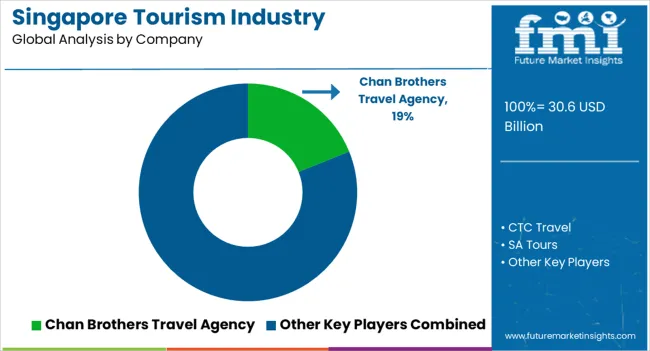
The Tourism Industry of Singapore is powered by the coexistence of the established players and the new innovative entrants. Knowing their way of doing business is important to companies that want to become players in this thriving segment.
Recent Developments in the Singapore Tourism Sector
Singapore Tourism Board (STB)
This government organization is the driving force behind the transformation of Singapore into a world-class tourism destination. They use tailored marketing campaigns and create new tourism products, such as those that are luxury, medical, or sustainable, as well as work with industry partners. STB adopts data-driven marketing, demonstrates virtual reality experiences to attract tourism, and joins hands with influencers to engage new audiences.
Marina Bay Sands
A famous integrated resort that provides the finest in leisure accommodation, entertainment, conventions, and shopping. Marina Bay Sands extends its services by adding new attractions such as the ArtScience Museum extension and celebrity chef restaurants. Moreover, they use digital tools to develop guest experiences based on individuals.
Changi Airport Group
Managing Changi Airport, Singapore, which is consistently rated as one of the best in the world. Changi Airport is a combination of retail, entertainment, and leisure facilities, which include a butterfly garden, a movie theater, and a rooftop pool, among others. They also embed contactless technology for passengers to save time.
Trip.com
A leading and well-established online travel agency with a strong presence in Asia. Trip.com applies AI and big data to the personalization of travel recommendations and competitive pricing. They also pay much attention to mobile-oriented experiences and seek out their clients of a particular group of travelers, such as millennials.
Klook
A well-known travel online channel that provides tickets for tours, activities, and attractions. Klook has hand-picked the most unique and localized experiences, provides real-time booking options, and socializes marketing through social networks with the younger generation.
Byond Travel
The startup from Singapore gives people the opportunity to have tailored and eco-friendly traveling adventures. Beyond Travel brings together travelers and local specialists to create bespoke itineraries tailored to distinct interests and a travel approach centered on responsible tourism.
Embrace Targeted Niche Tourism! The throwing of pebbles won't yield any results. Singapore has a wide appeal to people with different tastes. Extensive research may lead to the identification of a particular niche for which a business can be a shining example - medical tourism, luxury trips, sustainable traveling, or specializing in families with young kids.
Understanding the ideal customer and fitting the offering to their individual needs is one of the most important factors. There is no doubt that partnership with local businesses and experts will be an essential means to create memorable and authentic experiences that are always of real value.
Through the concentration on a narrow segment, the business stands a chance to become the leader at this level and to get a devoted customer base.
Collaboration is Key! The tourism industry's success in Singapore is dependent on networking. After the implementation of the "Singapoliday" marketing strategy developed by the STB, businesses can easily get more customers by simply taking advantage of the exposure which is provided by promotional opportunities.
Partnering with business entities such as hotels, tourist sites, and local businesses is a crucial point to consider. Work together to create combined itineraries and at the same time advertise products that will ensure that travelers are not only provided with a variety of experiences but also a sense of uniqueness.
Local experts and guides collaboration will ensure that presentations are authentic, appropriate, and enriching in enabling the tourists to gain insight of the Singaporean culture.
The global singapore tourism industry is estimated to be valued at USD 30.6 billion in 2025.
The market size for the singapore tourism industry is projected to reach USD 47.0 billion by 2035.
The singapore tourism industry is expected to grow at a 4.4% CAGR between 2025 and 2035.
The key product types in singapore tourism industry are domestic and international.
In terms of booking channel, online booking segment to command 59.0% share in the singapore tourism industry in 2025.






Full Research Suite comprises of:
Market outlook & trends analysis
Interviews & case studies
Strategic recommendations
Vendor profiles & capabilities analysis
5-year forecasts
8 regions and 60+ country-level data splits
Market segment data splits
12 months of continuous data updates
DELIVERED AS:
PDF EXCEL ONLINE
Singapore Leadership Development Program Market Trends- Growth to 2035
Tourism Independent Contractor Model Market Size and Share Forecast Outlook 2025 to 2035
Tourism Industry Analysis in Japan - Size, Share, & Forecast Outlook 2025 to 2035
Tourism Market Trends – Growth & Forecast 2025 to 2035
Tourism Industry Big Data Analytics Market Analysis by Application, by End, by Region – Forecast for 2025 to 2035
Assessing Tourism Industry Loyalty Program Market Share & Industry Trends
Tourism Industry Loyalty Programs Sector Analysis by Program Type by Traveler Profile by Region - Forecast for 2025 to 2035
Market Share Insights of Tourism Security Service Providers
Tourism Security Market Analysis by Service Type, by End User, and by Region – Forecast for 2025 to 2035
Competitive Overview of Geotourism Market Share
Geotourism Market Insights - Growth & Trends 2025 to 2035
Global Ecotourism Market Insights – Growth & Demand 2025–2035
Agritourism Market Size and Share Forecast Outlook 2025 to 2035
Art Tourism Market Analysis by, by Service Category, by End, by Booking Channel by Region Forecast: 2025 to 2035
Analyzing War Tourism Market Share & Industry Leaders
War Tourism Market Insights - Size, Trends & Forecast 2025 to 2035
Dark Tourism Market Forecast and Outlook 2025 to 2035
Food Tourism Sector Market Size and Share Forecast Outlook 2025 to 2035
Wine Tourism Market Analysis - Size, Share, and Forecast Outlook 2025 to 2035
Film Tourism Industry Analysis by Type, by End User, by Tourist Type, by Booking Channel, and by Region - Forecast for 2025 to 2035

Thank you!
You will receive an email from our Business Development Manager. Please be sure to check your SPAM/JUNK folder too.
Chat With
MaRIA